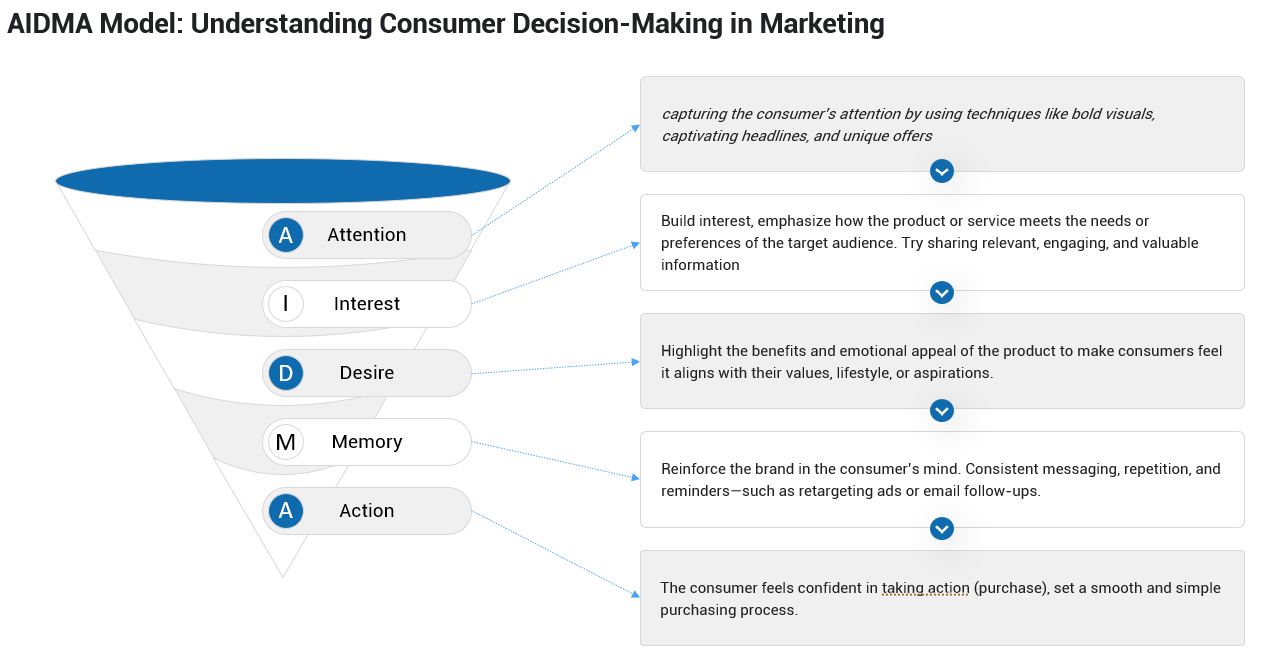A classic consumer-behavior model adding Memory to the AIDA journey to strengthen brand recall and conversion.
What is AIDMA Model
The AIDMA model is a powerful framework in marketing, helping business understand and influence each stage of the consumer journey, from initial awareness to final purchase.
The AIDMA model builds on the foundational AIDA model, introduced by American advertising pioneer E. St. Elmo Lewis in 1898. The original AIDA model outlined four stages of the consumer decision-making process: Attention, Interest, Desire, and Action. Over time, marketers recognized the need for a fifth stage—Memory—to account for how lasting brand impressions impact purchasing decisions.
The AIDMA model has been widely adopted for its deeper insight into consumer behavior, especially in competitive, fast-paced markets.
The Five Stages of the AIDMA Model
Here’s a closer look at each stage and its role in guiding consumers from awareness to action:
Attention
The journey starts with capturing the consumer’s attention. In a world crowded with marketing messages, standing out is essential.
Techniques like bold visuals, captivating headlines, and unique offers help to draw initial attention. The goal is to make a memorable first impression that pulls consumers in.
Interest
Once attention is secured, the next step is to build interest. At this stage, marketers emphasize how the product or service meets the needs or preferences of the target audience.
By sharing relevant, engaging, and valuable information, brands can create a genuine curiosity about what they offer, leading to deeper engagement.
Desire
After interest, the focus shifts to sparking desire.
Marketers highlight the benefits and emotional appeal of the product to make consumers feel it aligns with their values, lifestyle, or aspirations. This stage often uses storytelling, testimonials, or imagery to make the product desirable.
Memory
Memory is what sets AIDMA apart from AIDA. Here, the focus is on ensuring the product or brand is top of mind when consumers are ready to buy.
Consistent messaging, repetition, and reminders—such as retargeting ads or email follow-ups—help reinforce the brand in the consumer's mind, increasing the likelihood of recall.
Action
Finally, we reach the action stage, where consumers decide to purchase.
If all previous stages have been effective, the consumer feels confident in taking action. At this point, a smooth and simple purchasing process can convert interest into a completed sale.
Why the AIDMA Model is Valuable in Marketing
The AIDMA model allows marketers to map out strategies that resonate with consumers at each stage of their decision-making process.
By addressing each phase carefully, brands can improve their conversion rates, strengthen consumer loyalty, and increase brand recall.
This model also emphasizes the importance of consumer memory, especially crucial in highly competitive markets where brand recall can influence buying decisions.
Business Case
Here are two real-world examples that illustrate the AIDMA model in action:
Coca-Cola’s “Share a Coke” Campaign
Coca-Cola’s “Share a Coke” campaign provides a classic example of how AIDMA can drive consumer engagement and sales:
- Attention: Coca-Cola grabbed attention by replacing its iconic logo with popular first names on bottles, sparking curiosity and immediate interest among consumers.
- Interest: By allowing people to find a Coke bottle with their name or a friend’s name, Coca-Cola created a personal connection, increasing engagement and interest in the product.
- Desire: The campaign fueled a desire for connection and sharing, encouraging consumers to find and share their personalized bottles. Social media campaigns around this concept enhanced the appeal, making consumers want to be part of the trend.
- Memory: The “Share a Coke” concept became memorable through its personalization and widespread sharing on social media, making the experience unforgettable for many consumers.
- Action: Coca-Cola saw increased sales, as people were motivated to buy more bottles to find specific names, often buying multiple Cokes to share with friends or family.
This campaign increased both brand engagement and sales, showing the power of addressing each stage in the AIDMA model.
Nike’s “Just Do It” Campaign
Nike’s long-standing "Just Do It" campaign is a powerful example of the AIDMA model in action:
- Attention: Nike grabs attention with high-impact, inspirational ads featuring athletes like Michael Jordan, Serena Williams, and LeBron James. These powerful visuals and slogans resonate universally, drawing the viewer’s attention.
- Interest: Nike deepens interest by highlighting the stories and journeys of real athletes and individuals overcoming challenges. This resonates with audiences who relate to these aspirations, enhancing Nike’s connection with consumers.
- Desire: By associating its products with strength, perseverance, and success, Nike creates a desire for its shoes and athletic wear, positioning them as symbols of empowerment. The "Just Do It" mantra encourages people to pursue their goals, sparking emotional appeal and a strong connection to the brand.
- Memory: Nike’s consistent use of the "Just Do It" slogan across media ensures that it stays memorable. The slogan and brand have become deeply embedded in consumer memory as a representation of resilience and determination.
- Action: Nike provides an easy path to purchase through its website, mobile app, and stores, making it convenient for consumers to act on their desire to buy Nike products.
This approach has helped Nike establish lasting brand loyalty and high recall, allowing the brand to drive ongoing sales and deepen its influence in the athletic industry.
Link
Template for Practice
Get into the real practice now.






